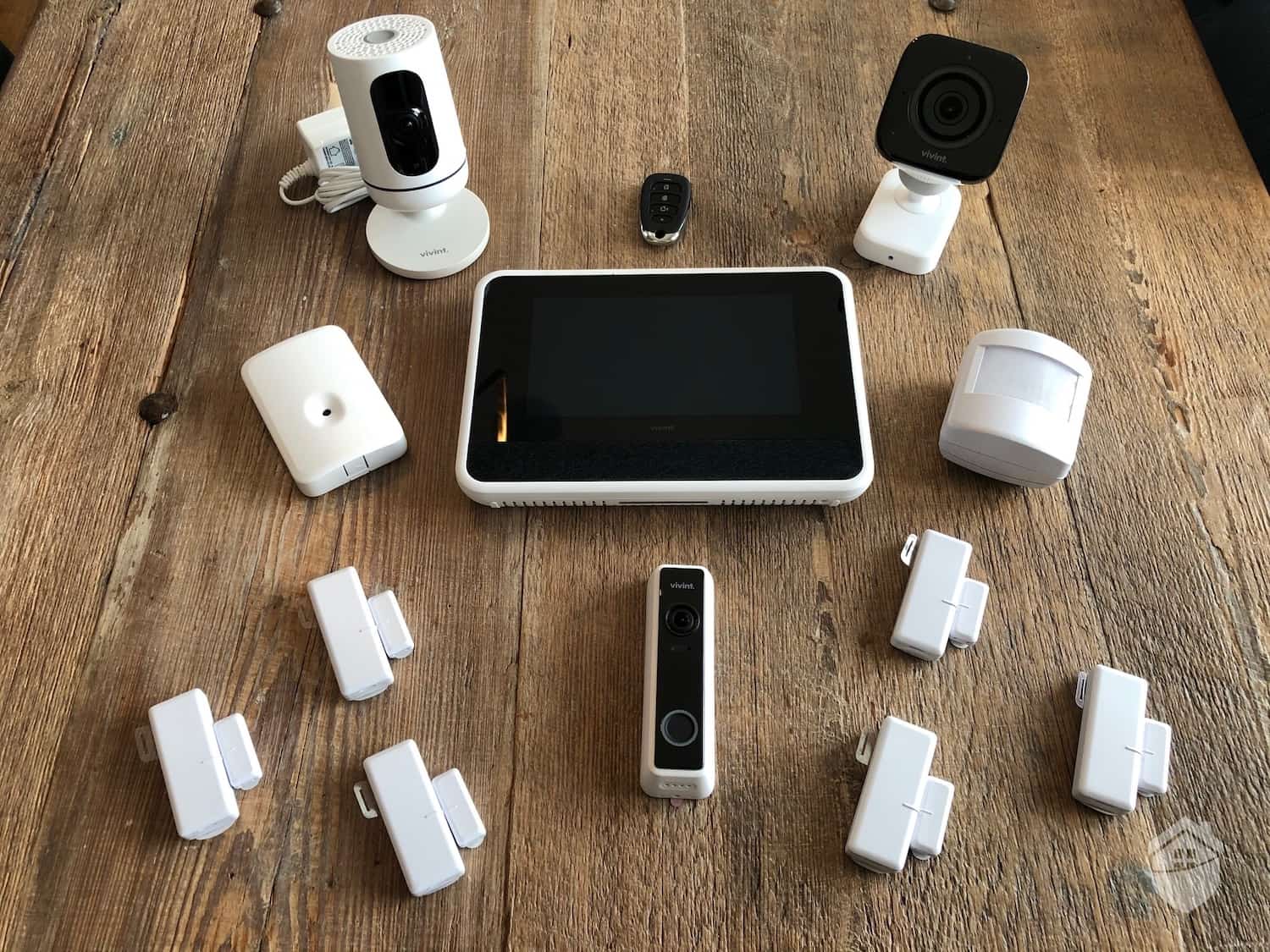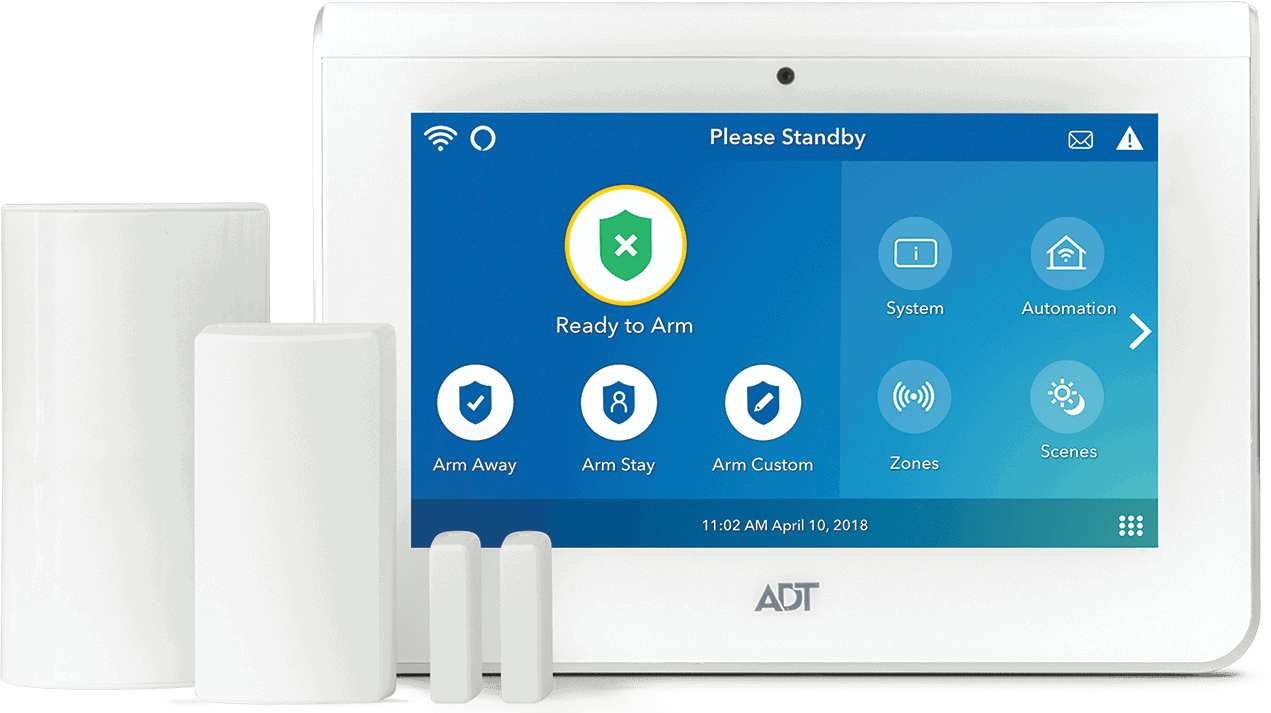Love it or hate it, some home security companies want you to sign on the dotted line before enjoying their equipment and service. We’ve seen this from big-name brands like Frontpoint, and even today ADT and Vivint require contracts to get started. Well, “require” isn’t exactly the word, but we’ll get to that.
We recently contacted a Vivint representative and had them set us up with a smart home security system (Vivint turned out to be one of our favorites!). Of course, we first pored over the contract with a fine-tooth comb before signing our life away.
Truth is, there’s a lot of scuttlebutt about how strict Vivint is with their contracts. But we actually found some fine-print policies that helped take the edge off for us. At the end of the day, Vivint’s contracts aren’t so bad — though we do share a few caveats to consider. Without further ado, let’s check it out.

Unboxing the Vivint Smart Hub
Pro Tip: Need to get out of a Vivint contract? Just enlist in the military! We say it tongue-in-cheek, but Vivint does have “outs” for active service members. We share all about that and other important contract considerations in this guide. (PS – we support our troops, but there are easier ways to get out of your Vivint contract than enlisting in the Army).
Overview of Vivint Contracts
We’ll be honest, if you do engage in a Vivint contract, expect to be on-the-hook for at least a few years. Their contract terms range between 42- and 60-months — and if you’re doing the math, that’s three and a half years to 5 years. These terms are a bit longer than ADT's contracts, which typically lasts three years (or two years in California).
Now, this doesn’t mean you should write Vivint off and go with a no-contract home security system. That’s an option, but we think that’s throwing the baby out with the bathwater. There’s so much to love about Vivint, especially if you’re a homeowner and you plan on staying in your home for a few years.
Also, Vivint only requires a contract if you choose to finance your equipment over time. In which case, they want to contractually bind you into making your monthly payments, which is not only par for the course, it’s par for life. So in a sense, they don’t “require” a contract at all.
Vivint’s Month-to-Month Options
If you’re willing to purchase your Vivint equipment upfront, then you’ll only have to pay for Vivint monitoring on a month-to-month basis. This is ideal, but we understand that money doesn’t grow on trees, and Vivint sells some of the most expensive equipment on the market.
Expect to shell out about $500-$600 for a Vivint Smart Hub, a handful of door/window sensors, and a motion sensor. If you want the works (which is what we got), you’ll be spending upwards of $1,000 or more on a Smart Hub, sensors, indoor and outdoor cameras, and a smart doorbell camera. And keep in mind that you’ll still have a monitoring bill coming in at $30-$45 per month. In our case, since we had cameras, we had to go with the most expensive monitoring plan.
Pro Tip: If you choose Vivint to protect your home and family, we highly recommend Vivint’s premium Smart Control monitoring plan. This plan starts at $45 per month, but it gives you total smart home control plus video support.
For some folks, contracts aren’t a big deal, in which case we’d recommend going with Vivint’s zero-interest financing. For others, contracts are to be avoided like the plague. We’re somewhere in the middle. We’d rather go month-to-month, but we also see Vivint’s contracts as a tool if you don’t have the cash on-hand for a full smart home system. After all, there's no interest if you have your system financed, so really, the contract is the only tradeoff. At any rate, you have options.

Vivint Smart Home Equipment
Vivint’s Cancellation Policy
All right, so you’re about to sign a Vivint contract, but first you want to know about their cancellation policy. Smart!
To cancel your contract, you can either snail mail, email, or fax a written Notice of Cancellation to the company. Be sure to do this at least 30-days before your intended cancellation date. Include the following info on your cancellation notice:
- The date of the cancellation letter
- Your Vivint service number
- Your intent to cancel your contract
- A brief explanation of why you wish to cancel
- Your signature
So… that sounds pretty easy. Well, not so fast. You’ll still be on the hook for your remaining equipment balance when you cancel. And let’s not forget the penalty for early cancellation (last we heard it was $300 during year one, and $150 after that).
Now you might be asking, “isn’t there a way to cancel without a penalty?” And the answer just might surprise you. Let’s dig into that next.
How to Cancel A Vivint Contract Without Penalty
In some ways, Vivint drives a hard bargain. But there are a number of ways to get out of the contract without paying a penalty. Of course, this is all in the fine print… but why read the fine print when we share it loud and proud right here?
Just note that the following “contract nullifiers” must be reviewed by Vivint’s Exceptions Review Team. It’s not as easy as calling in and saying “fare thee well.” The company will handle each cancellation request on a case-by-case basis.
Special Circumstances for Penalty-Free Contract Cancellation
Right of Rescission — When our Vivint technician Don installed our equipment, he also handed us two copies of the ‘Notice of Cancellation’. It explicitly said that we had three days to cancel our service without penalty. Since most companies offer a 30-day money back guarantee (ADT offers a 6-month guarantee!), we weren’t thrilled with Vivint’s 3-day “return policy.” But something’s better than nothing.
FYI: The Right of Rescission isn’t exactly a return policy. It’s actually required by law that all consumers get three days to return a product, service, or loan without penalty. This is colloquially referred to as the “buyer’s remorse law.”
Life or Death — Another way you can get out of your Vivint contract is if you die. We know it sounds crass, and it’s kind of ridiculous that Vivint would even need to write this in the contract. But the truth is, many debts transfer to the deceased person’s estate; but Vivint doesn’t. So thankfully, your loved ones will have one less thing to worry about if you happen to pass. Rest assured they can cancel your Vivint contract without an issue.
Move to Retirement Home — You can also cancel your Vivint contract penalty-free if you move into a nursing home or retirement home. After all, if it’s a half-decent establishment, they’ll already have a security system in place. We’re glad that Vivint put this clause in the contract, as the decision to move into a retirement home is often out of your hands. If you’re a mature adult, read about our top-rated home security systems for seniors here.
Bankruptcy or Bust — Do not pass go, do not collect $200. We know bankruptcy is nothing to joke about, as it happens to a lot of good people for various reasons. If you’ve found yourself in a world of financial trouble, Vivint offers an “out” for folks like you. Just be sure to keep all of your bankruptcy records organized and ready to share with the Exceptions Review Team.
Military Deployment — If you’re active duty or reserve military and you’re about to be deployed for 6+ months, then you can get out of your Vivint contract scot-free. This is also true if you receive PCS orders, if you’re medically discharged, or go into retirement for 20+ years. But again, have your official orders ready to go.
Did You Know: Vivint is one of the best home security systems for active service members. With the “Military Moves” program, you can have your system moved without paying any relocation, reinstallation, or reactivation fees. You can also defer payment up to one year if you’re temporarily transferred away from home.
Qualified Candidate Takeover — This one comes with a penalty, but if a friend or family member is willing to take over your Vivint agreement, at least you won’t be on the hook for your equipment balance and monitoring fees going forward. In our case, we had a few houseguests ooh-ing and ahh-ing at Vivint’s smart home capabilities (especially with the cameras). So we think this will be an easy out for some folks.
What Happens to My Contract if I Move?
Bon voyage Vivint? Unfortunately, you cannot get out of Vivint’s contract just because you move across town, across the country, or even across the world. With that said, Vivint does offer some great moving options, and they have a whole team (called Move Specialists) dedicated to relocating current users. From what we’ve seen, they’re flexible to work with users to find a solution here.
When you move with Vivint, you can:
- Customize a new Vivint system from the ground-up
- Take down and move your existing Vivint system yourself
- Have Vivint Smart Home Pros take down and reinstall your system for you
Pro Tip: If you’re between homes for a few months, take advantage of Vivint’s deferment plan. This allows you to suspend your service until you’re resettled in your new home.
It’s worth mentioning that Vivint doesn’t offer service out of the country. So if you’re prone to wander, think long and hard before signing with Vivint. But if you’re simply moving within your city, state, or within the country, reach out to Vivint 2 weeks before the big move; they’ll need to pencil you in for professional installation.
One final note on moving with Vivint. Our technician Don (pictured below) told us that when we decide to move, he would personally drop by to spackle and paint any drill holes he left in our wall (if you’re reading this, Don, we’re holding you to your word). That’s a nice little touch and speaks to their end-to-end service.

Photo of our Vivint Installation Specialist, Don
Vivint Warranty and Service Plans
Vivint’s default warranty leaves something to be desired. Your equipment is covered for 120 days (4 months), while we normally see 1- to 3-year warranties from other home security brands. You can still get your equipment serviced after the first 4 months, but you’ll have to fork out $49 per Smart Home Pro visit. Note that each service visit does come with a 60-day guarantee, which we think is nice.
Your other option is to purchase the Premium Service plan for an additional $10 per month. We decided to go this route, so if we need Vivint’s help for any reason, all service visits are covered (we won’t pay a dime extra). Since we have over $1,000 invested in Vivint, what’s an extra $10 per month to ensure our system remains in tip-top shape? That’s money well spent in our book.
Billing Options
Vivint prefers paperless billing and auto-withdrawal (of course). You can set this up in your Vivint account online if you like auto payments. You can also choose direct invoice billing (snail mail), or you can pay manually online each month. We were a bit surprised by our first bill to be honest — and not necessarily in a bad way. It just seemed really official and professional; not something we’d expect from a home security company. But then again, Vivint is positioned as an industry leader from a customer experience standpoint.
Did You Know: Vivint offers Flex Pay payment plans for equipment financing. Note that this zero-interest installment agreement covers the Vivint products you purchase, as well as any installation and activation fees. However, it does not cover monthly monitoring fees. A credit check is also required. Have a look at Vivint’s most recent plans and pricing here.
Installation and Activation Fees
Keep in mind that you may have to pay for installation and activation with Vivint. The company charges anywhere between $49-$199 for installation (depending on the equipment you buy), and a $99 one-time activation fee. This is fairly standard for professionally installed home security systems, and it’s in-line with ADT and their installation charges.
Now, you don’t always have to pay Vivint’s installation fee. The company frequently runs deals and promotions that waive the installation and activation costs. This can save you a couple hundred dollars, so it’s worth keeping an eye on our Vivint deals page here.
The Bottom Line on Vivint Contracts
If you’re completely turned off by contracts, Vivint might not be the best fit for you. While they don’t require a contract if you pay for your equipment upfront, Vivint will lock you into a 3-5 year agreement if you wish to finance your system. So think of it like purchasing a shiny new smartphone like an iPhone (which can cost upwards of $1,000 or more!). Thankfully, if your credit is decent, you’ll just get on a payment plan and spread those payments over the coming years. Same deal with Vivint.
Of course, if you can swing it, we do think it’s best to bite the bullet and pay for your Vivint equipment upfront. But if you have to sign a contract, we do think it’s worth it to get one of the best smart home security systems on the market. In our experience, Vivint impressed us in just about every category. And for that, a little ink-on-paper isn’t the end of the world. This is especially true for homeowners with a bit of disposable income to work with. That’s our story, and we’re sticking to it.






